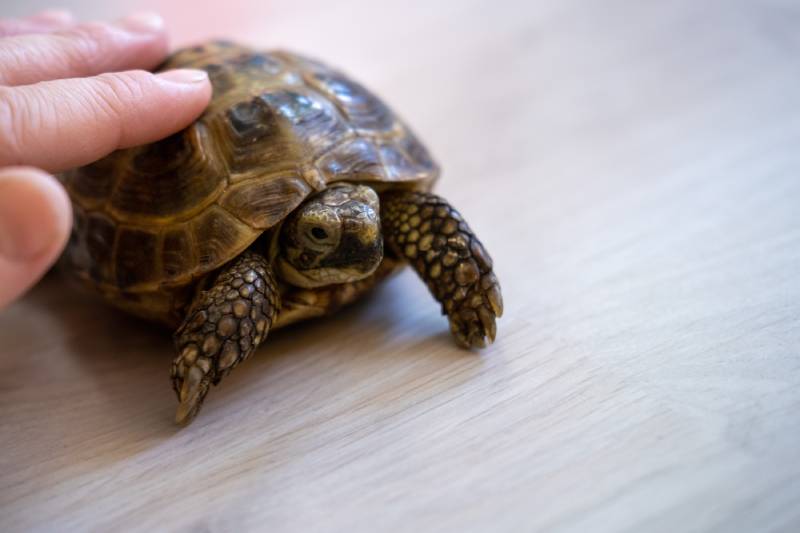
If you’re a turtle owner and weren’t informed of your pet’s sex upon purchasing it, you might be wondering how on earth you can tell whether they are a male or female. It can be difficult determining what sex a turtle is, but there are a few ways to figure this out. It should also be noted that for some turtle species, it will be easier to tell the sex than others, and you’ll likely have a simpler time making a determination after your turtle reaches sexual maturity.
How exactly can you decipher your pet turtle’s sex? With these seven expert tips! With the tips below, you should be able to determine the sex of most turtles. If one way doesn’t make it clear whether your pet is male or female, try another! Or, ideally, go through all the ways to check a turtle’s sex, then add up what you get to determine if your pet is male or female.

The 7 Ways to Tell If a Turtle is Male or Female
1. The Size of the Shell
Checking the size of your turtle’s shell is one way to find out the sex (though this really only works after your pet is fully grown). In many turtle species, the female will have a shell just a bit longer than the male’s (though there are a few species where this may not apply). However, because there could be some overlap in how long the shell of a smaller female and larger male turtle are, this isn’t the most precise method of figuring out whether your turtle is male or female.

2. Check the Plastron
The plastron is the bottom of the turtle shell (aka, the belly) and can also be used to help figure out the sex. In males, the plastron will be slightly concave (or will go inwards), while a female turtle’s plastron will be flat. A male’s plastron has this shape to make it easier for the male to mate the female without rolling off during the process. You’ll want to be careful when checking the plastron, as your turtle likely won’t be a fan of being turned over. It’s best to pick your pet up nearer their tail so they aren’t able to bite you.
3. The Length of the Tail
This way of checking a turtle’s sex isn’t foolproof but can help in the overall determination. Male turtles typically have longer, thicker tails than females. Why is that? This is because the genitalia of a male turtle are located in the tail, so to fit that in there, it must have more room. Like measuring a turtle’s shell, though, there can be an overlap in tail sizes of females and males, so this method of determining sex might not be accurate. However, you can add this to the complete picture to help figure out whether your pet is male or female.

4. Look for a Tail Notch
This one is a very subtle difference between male and female turtles, so you might not be able to tell your pet’s sex in this way. But male turtles usually have a notch at the rear of the carapace shaped like a “V”. The reason they have this is to accommodate the tail during mating; without that notch, the male’s tail could be crushed on the underside of the turtle’s shell.
5. Find the Cloaca
Checking where this is located is a good way to help figure out if your turtle is male or female. What is the cloaca? It’s an opening on the bottom of the tail that eliminates waste and aids in reproductive function. In males, this opening is longer and looks like a slit; it is also located further from the body and closer to the tail’s tip. However, in females, it is rounder, looks like a star, and is closer to the base of their tail where it meets the body.

6. The Length of the Claws
Claw length is another good indicator of sex. The front claws on males tend to be much longer because they are used during mating rituals when the male will grab onto the upper shell of a female with them. Males also use their longer front claws to fight. However, females will have short, stubby claws on their front feet.
7. Check Species Specific Features
Some turtle species will have body features that are specific to their sex. For example, 90% of the time, male American box turtles have orange or red irises, whereas females have yellow or brown irises. And in Sun turtles, males have blue coloring on their underbelly, while females do not. Not every turtle species will have characteristics specific to the sex, but it’s worth looking into. You can easily find out whether you can use this method by looking up your turtle online.


Conclusion
There are several ways to determine whether your turtle is a male or female, but it’s wisest to use a few of these methods, then see what they all add up to. A few of the ways of checking the sex of a turtle might have some overlap, so they won’t be 100% accurate. However, checking all these things after your turtle has reached full growth can help you make a more precise determination!
Featured Image Credit: a female owner holding her pet turtle








